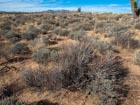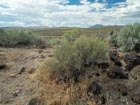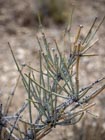
A plant in the Mojave desert of California in December, when it takes on a bronze hue and leaves or flowers are generally absent; it remains identifiable by the branching architecture [C. J. Earle, 2012.12.21].

A plant at the White River Narrows in Nevada; note the branching architecture, which distinguishes it from the parallel stems of E. viridis [C. J. Earle, 2020.05.28].

Detail showing branch architecture and remnants of cones in September on a plant in east-central Nevada [C. J. Earle, 2021.09.13].

Conservation Status

Ephedra nevadensis
S. Watson 1879
Common names
Nevada ephedra (Stevenson 1993), Nevada jointfir (Jaeger 1969).
Taxonomic notes
Synonymy:
- Ephedra antisyphilitica S. Watson 1871, not Berlandier ex Meyer 1846;
- Ephedra antisyphilitica S. Watson var. pedunculata S. Watson;
- Ephedra nevadensis S. Watson subvar. paucibracteata Stapf;
- Ephedra nevadensis S. Watson f. rosea H.C. Cutler.
Description
Dioecious, erect shrubs to 1.5 m tall. Bark gray, fissured. Branches alternate or whorled, stiff, angle of divergence about 45°. Twigs pale green, becoming yellow with age, not viscid, glaucous, with numerous longitudinal grooves; internodes 1-6 cm. Terminal buds conic, 1-3 mm, apex obtuse. Leaves opposite (rarely in whorls of 3), 2-4(-8) mm, connate to 1/2-3/4 their length; bases thickened, brown, completely deciduous; apex obtuse. Pollen cones 1 to several at nodes, ellipsoid, 4-8 mm long, sessile or on short peduncles with 2 pairs of basal bracts; bracts opposite, in 5-9 pairs, yellow to light brown, obovate, 3-4 × 2-3 mm, membranous; bracteoles slightly exceeding bracts; sporangiophores 3-5 mm long, exserted to 1/4-1/2 their length, with 6-9 sessile to short-stalked (less than 1 mm) microsporangia. Seed cones 1 to several at nodes, nearly globose, 5-11 mm long on long peduncles, with 1-2 pairs of basal bracts; bracts opposite in 3-5 pairs, nearly circular, 4-8 × 3-6 mm, herbaceous, with light brown to yellow-green center, occasionally pinkish, margins entire. Seeds (1-)2, ellipsoid, 6-9 × 2-4 mm, brown, smooth. Pollen cones active late winter to mid-spring (Stevenson 1993).
Stevenson (1993) provides this Key to the North American species of Ephedra. The Jepson eFlora key is also useful for distinguishing it from other Ephedra native in California.
Distribution and Ecology
US: Oregon, California, Arizona, Nevada & Utah in the Mojave and Colorado deserts at 700-1900 m on dry, rocky slopes and hills, rarely in sandy flat areas (Jaeger 1969, Stevenson 1993).
Remarkable Specimens
No data as of 2023.03.03.
Ethnobotany
Observations
See the observations on iNaturalist, accessed 2021.12.30.
Remarks
The epithet refers to this species' widespread occurrence in the state of Nevada.
Citations
Watson, Sereno. 1879. Contributions to American botany. II. Descriptions of some new species of North American plants. Proceedings of the American Academy of Arts and Sciences 14:298. Available: Biodiversity Heritage Library, accessed 2021.12.31.
See also
Species profile at Plants of the World Online, accessed 2021.12.30.



